How to connect a heating battery in a private house
The efficiency of the heating system depends on a number of factors, including the connection of batteries is very important. After all, if the connection is incorrect, a part of the radiator may remain cold even at a high temperature of the coolant. Therefore, in this article we will look at how to connect the radiators correctly and in what cases, which schemes should be used.
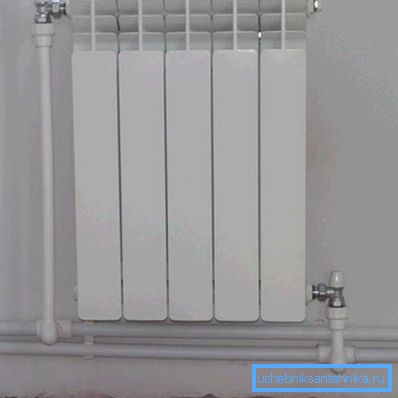
Connection Features
Ways to connect radiators
When constructing heating systems in private homes, the following connection methods are used:
| One way | In this case, the supply pipe is connected from above, and the return pipe is connected to the same section from below. This connection diagram of the heating battery allows the radiator to heat up evenly. However, if the accordion has a large number of sections, there will be significant heat loss, respectively, it is better to use other connection options. |
| Seat and lower | This method is an excellent option for when the pipes are in the floor. The connection is made to the pipes located at the bottom of the structure in opposite sections. The disadvantage of this method is only low efficiency, since heat losses can reach 15 percent. |
| Diagonal | It is used when connecting devices with a large number of sections. As it is easy to guess, the supply pipe in this case is connected from above, and the discharge pipe is from below, in the opposite section. This scheme of connecting the radiators in a private house contributes to an even distribution of the coolant and maximum heat transfer from the appliances. |
Note! When using a thermostat for heating parallel to the radiator, a bypass must be performed. This will allow you to adjust the degree of heating of the device.
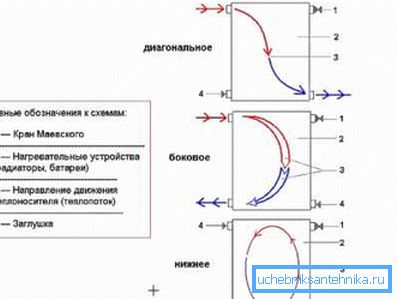
As we see, the methods of connecting radiators depend on a number of factors, such as the method of laying pipes, equipment power, etc. In particular, the type of system is of great importance. We will talk more about the types of heating systems below.
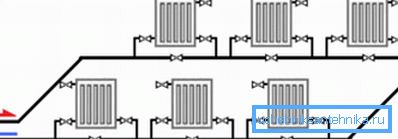
Types of system
At the device of heating systems apply two schemes:
- One pipe - is the simplest, since the coolant circulates through a single pipe, to which heating devices are connected in series. Its disadvantage is that it does not allow to regulate the flow of heat. Therefore, the heat transfer corresponds to the design rate established during the design. This scheme is used in small systems, as with a large pipeline length and a large number of radiators, the devices will heat up unevenly.
- Double pipe - its meaning is that hot water flows through one pipe, and the cooled one returns to the boiler through another.. The connection of radiators in a private house in this case is carried out, respectively, in parallel. The advantage of this device is the uniform heating of the sections, as well as the ability to adjust heat transfer. Among the shortcomings, it is possible to single out only the need for a larger number of pipes, respectively, the cost of construction increases.
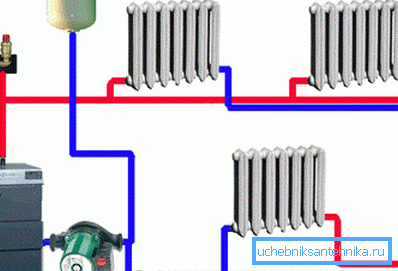
It should be noted that regardless of the type of system, the connection of radiators with their own hands can be implemented in two ways:
- According to the vertical scheme - the heating device is connected to a vertical riser, from which the wiring to the radiators is performed.
- According to the horizontal scheme - the coolant is circulated through horizontal pipelines.
The choice of the scheme of connecting the radiators depends on the particularities of the house. For example, if a dwelling contains several floors, the connection is realized in a vertical pattern.
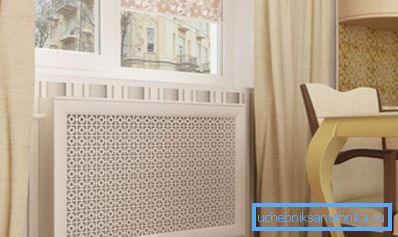
Location selection
When deciding how to properly connect the heating battery, it is imperative to determine the location of the heaters. The fact is that the function of radiators is not only to heat the premises, but also to create a heat shield that prevents the penetration of cold into the room. It is for this reason that they are installed under the windowsills.
From this it follows that the heating devices must be installed in the places of the greatest heat losses. Therefore, before you decide on the method of connection, it is necessary to draw up a diagram with their location.
In addition, it is important to correctly determine the installation distance, which will allow for maximum heat transfer from the devices. So, these distances should be as follows:
| From the bottom of the window sill | 100 mm |
| Off the floor | 120 mm |
| Off the wall | 20 mm |
It is not recommended to violate these regulations.
Note! The sill should not block or block the heater, as this will significantly reduce the efficiency of heat generation. However, in some cases, radiators may be covered with grills. Most often this is done when the heating devices do not fit into the interior of the room.
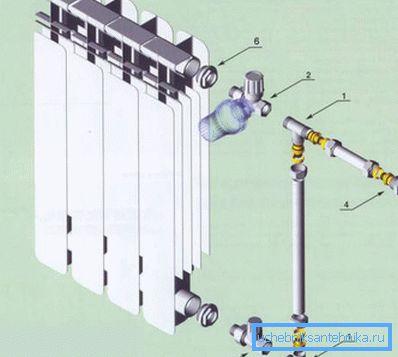
Installation
Connect the heating battery should be in the warm season, so as not to remain in the winter without heating. Therefore, it is necessary to purchase all components in advance in order to carry out all the work quickly.
Note! It is possible to acquire heating devices only after the scheme of heating will be made. This will allow you to choose the correct location of the connecting pipes. In addition, you must first calculate their power, how it is done, you can find out on our portal.

Proceed to the installation work needed after finishing the room.
The instruction is as follows:
- If the replacement of old radiators is carried out indoors, then first of all it is necessary to dismantle the elements of the old construction.
- Then it is necessary to determine the location of the construction position and make corresponding marks on the wall. In this case, you need to use the construction level, so that the structure was installed exactly.
- Then you need to fix your own brackets with dowels.
- After that, the device should be installed on the brackets according to the instructions that are usually included with the radiators.
- After installation of devices it is necessary to connect them to the pipeline. This operation depends on the type of pipe. For example, if the pipeline is implemented with plastic pipes, radiators are connected using a special fastening element - “American”.

At this stage ball valves are installed, as well as Mayevsky cranes. It should be noted that when using a heating battery with a bottom connection, it is not necessary to perform a bypass and install control valves. The latter, as a rule, is used in two-pipe systems with diagonal and lateral joints.
When installing valves, care must be taken to ensure easy access to it, even if the radiators themselves are closed.
- At the end of the work, you can fill the system with a coolant and perform pressure testing.
Note! In the design and installation of heating, you must comply with the requirements that contain SNiP 3.05.01-85.
Here, in fact, all the main features for connecting heating batteries.
Conclusion
By itself, the connection of radiators is not a big deal. However, for the system to be effective, it is first necessary to correctly draw up its scheme. For this you need to take into account a number of factors, therefore, the preparation of the project should be done very carefully.
From the video in this article, you can pick up some additional information on this topic.